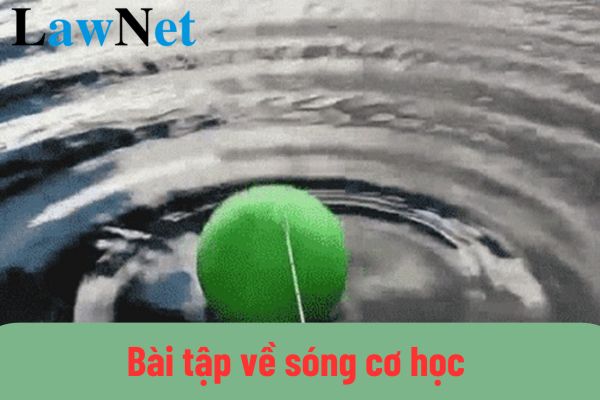Vietnam: What are the mechanical wave exercises? What are the perspectives on developing the 12th-grade Physics curriculum?
What are the mechanical wave exercises in Vietnam?
Mechanical wave exercises typically involve concepts and properties of waves transmitted through physical media, such as longitudinal, transverse, sound, and surface water waves. These exercises may require calculations of amplitude, frequency, velocity, wavelength, or wave propagation through different media.
The question "What are the mechanical wave exercises in Vietnam?" is studied and practiced in the 12th-grade Physics curriculum.
|
What are the mechanical wave exercises in Vietnam?
|
*Note: The information about the mechanical wave exercises is for reference only./.

What are the mechanical wave exercises in Vietnam? What are the perspectives on developing the 12th-grade Physics curriculum? (Image from the Internet)
What are the perspectives on developing the 12th-grade Physics curriculum in Vietnam?
According to the General Education Program for Physics issued with Circular 32/2018/TT-BGDDT, specific regulations are provided as follows:
The Physics curriculum comprehensively adheres to the basic regulations stated in the General Program, regarding perspectives, objectives, requirements to achieve, educational plans, educational content, teaching methods and evaluation of results, conditions for implementation and program development; the direction for developing curricula of subjects and educational activities; while emphasizing the following perspectives:
- The Physics curriculum inherits and enhances the advantages of the current program and, on the other hand, absorbs the experiences of curriculum development in countries with advanced educational systems worldwide, while also approaching achievements in educational science and physics science in a way that aligns with students' cognitive levels and psychology and physiology, taking into account the economic and social conditions of Vietnam.
- The Physics curriculum focuses on the nature, and significance of physical objects, emphasizing practicality; avoiding a tendency towards mathematics; creating conditions for teachers to help students develop scientific thinking from a physics perspective, inspiring interest in students, and enhancing the ability to apply physical knowledge and skills in practice. The topics are designed and arranged from intuitive to abstract, from simple to complex, and from a system considered as one particle to many particles; initially, to approach some modern, practical core contents.
- The Physics curriculum is built with an open approach, reflected in the non-specific detailing of the teaching content but only stipulating the requirements students need to achieve; providing specific definitions only for concepts where there are different understandings.
Based on the requirements to achieve, textbook authors are proactive and creative in deploying specific teaching content according to the program's development requirements. On the basis that they must closely follow and meet the objectives and requirements set by the Physics curriculum, teachers may choose to use one or a combination of several textbooks and various resources for teaching.
- Within a class, the order of teaching topics (including mandatory topics and optional modules) is not rigidly fixed, allowing textbook authors and teachers to be creative in a reasonable way, so as not to disrupt the logical formation of knowledge and skills and not to restrict opportunities for the formation and development of students' qualities and capabilities.
The order of teaching topics is implemented so that the topic describing a physical phenomenon is conducted first to give an overview of the phenomenon, followed by the topic explaining and researching the phenomenon to provide a deeper physical basis, and then the topic of the phenomenon's application in science or practical situations.
- The educational methods of Physics encourage and develop the proactive and creative nature of learners, aiming for the formation and development of capabilities.
What are the features of 12th-grade Physics in Vietnam?
According to the General Education Program for Physics issued with Circular 32/2018/TT-BGDDT, the features of Physics are as follows:
- Physics is a science that studies the simplest and most general forms of motion of matter and the interactions between them.
- In general education, physics education is conducted at all three educational levels with varying degrees.
- In the basic education stage (elementary and lower secondary education), physics content is addressed in the subjects: Nature and Society (grades 1, 2, 3); Science (grades 4, 5); Natural Science (grades 6 to 9).
- In the career-oriented education stage (high school), Physics is a subject within the group of Natural Sciences, chosen based on students' aspirations and career orientations. Students oriented towards careers requiring extensive use of physics knowledge and skills are offered additional learning modules.
- Physics helps students continue to develop qualities and competencies formed in the basic education stage, providing conditions for students to initially recognize their abilities, and strengths, and show a positive attitude towards the subject.
- Based on the foundational content provided to students in the basic education stage, the Physics curriculum selects and develops the most essential practical issues, while also focusing on highly applicable issues that form the basis for many engineering, science, and technology fields.
- Experiments and practices play a particularly important role in forming concepts, principles, and physical laws. Therefore, the Physics curriculum emphasizes training students in the ability to explore the properties of physical objects through experimental and practical content from different perspectives.
- The Physics curriculum values training the ability to apply learned knowledge and skills to understand and solve certain practical problems, meeting the demands of life; while ensuring the development of physics capabilities—an expression of natural science capabilities—and meeting students' career orientation needs.
- Through the Physics curriculum, students form and develop a scientific worldview; practice self-confidence, honesty, and objectivity; appreciate the beauty of nature; love nature, are proud of the nature of their homeland, country; respect the laws of nature, cherish, and preserve and protect nature, and behave with nature in a way that suits sustainable development requirements; at the same time forming and developing self-control and self-learning capabilities, communication and cooperation skills, and problem-solving and creativity skills.

